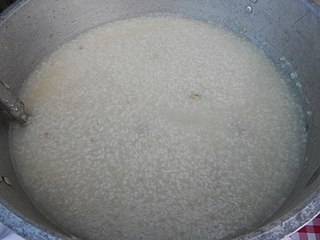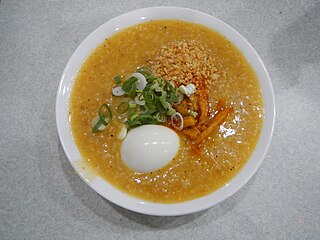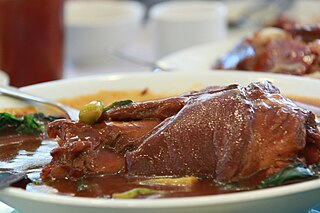Related Research Articles

Sinigang is a Filipino soup or stew characterized by its sour and savory taste. It is most often associated with tamarind, although it can use other sour fruits and leaves as the souring agent. It is one of the more popular dishes in Filipino cuisine. The soup is usually accompanied by rice. In 2021, sinigang was rated as the world's best vegetable soup by TasteAtlas.

Dinuguan is a Filipino savory stew usually of pork offal and/or meat simmered in a rich, spicy dark gravy of pig blood, garlic, chili, and vinegar.

Lugaw, also spelled lugao, is a Filipino glutinous rice dish or porridge. Lugaw may refer to various dishes, both savory and sweet. In Visayan regions, savory lugaw are collectively referred to as pospas. Lugaw is widely regarded as a comfort food in the Philippines.

Paksiw is a Filipino style of cooking, whose name means "to cook and simmer in vinegar". Common dishes bearing the term, however, can vary substantially depending on what is being cooked.

Balbacua, also spelled balbakwa or balbakoa, is a Filipino beef stew made from beef, collagen-rich beef parts, and various spices cooked for several hours until very tender. It is typically served with white rice or misua or miki noodles. It originates from the Visayan regions of the Visayas and Mindanao islands.

A stew is a combination of solid food ingredients that have been cooked in liquid and served in the resultant gravy. Ingredients can include any combination of vegetables and may include meat, especially tougher meats suitable for slow-cooking, such as beef, pork, venison, rabbit, lamb, poultry, sausages, and seafood. While water can be used as the stew-cooking liquid, stock is also common. A small amount of red wine or other alcohol is sometimes added for flavour. Seasonings and flavourings may also be added. Stews are typically cooked at a relatively low temperature, allowing flavours to mingle.

Nilaga is a traditional meat stew or soup from the Philippines, made with boiled beef or pork mixed with various vegetables. It is typically eaten with white rice and is served with soy sauce, patis, labuyo chilis, and calamansi on the side.

Goto, also known as arroz caldo con goto, is a Filipino rice and beef tripe gruel cooked with ginger and garnished with toasted garlic, scallions, black pepper, and chicharon. It is usually served with calamansi, soy sauce, or fish sauce (patis) as condiments, as well as a hard-boiled egg. It is a type of lugaw.

Afritada is a Philippine dish consisting of chicken, beef, or pork braised in tomato sauce with carrots, potatoes, and red and green bell peppers. It is served on white rice and is a common everyday Filipino meal. It can also be used to cook seafood.

Ginataang kalabasa, also known as kalabasa sa gata, is a Filipino vegetable stew made from calabaza in coconut milk and spices. It commonly includes shrimp and yardlong beans and either bagoong or patis. It can also be cooked with fish, crab, or meat and a variety of other ingredients. It is a creamy umami-laden dish that is naturally slightly sweet due to the calabaza. It is a type of ginataan.

Sopas is a Filipino macaroni soup made with elbow macaroni, various vegetables, and meat, in a creamy broth with evaporated milk. It is regarded as a comfort food in the Philippines and is typically eaten during breakfast, cold weather, or served to sick people.

Pata tim, also spelled patatim, is a Filipino braised pork hock dish slow-cooked until very tender in soy sauce, black peppercorns, garlic, bay leaves, and star anise sweetened with muscovado sugar. It also commonly includes péchay and mushrooms. The dish is commonly served in regions in the Philippines with large Chinese Filipino populations, especially in the Binondo district of Manila.

Ginataang ampalaya, is a Filipino vegetable stew made from bitter melon and tinapa in coconut milk, bagoong alamang, and spices. The dish can also be made with pork or shrimp and other vegetables. The dish is characteristically savory and slightly bitter due to the ingredients used. It is a type of ginataan.

Ginataang labong or ginataang tambo is a Filipino vegetable stew made from bamboo shoots in coconut milk and spices with seafood or meat. It is the most common way of preparing bamboo shoots in Philippine cuisine. Ginataang ubod is a variant of the dish made with heart of palm but is otherwise prepared identically. It is a type of ginataan.
Kadyos, baboy, kag lanka, commonly shortened to KBL, is a Filipino pork soup or stew originating from the Hiligaynon people of the Western Visayas islands. The name of the dish means "pigeon peas, pork, and jackfruit"; the three main ingredients. The soup is also traditionally soured with batuan fruits. Other souring agents like tamarind can also be used. Other ingredients include leafy greens, lemongrass, fish sauce, onions, and siling haba peppers. The pork cut used is typically the hock (pata). The dish is characteristically purple in color due to the use of pigeon peas. It is similar to another Hiligaynon dish known as kadyos, manok, kag ubad which uses chicken and banana pith instead.
Kadyos, manok, kag ubad, commonly shortened to KMU, is a Filipino chicken soup or stew originating from the Hiligaynon people of the Western Visayas islands. The name of the dish means "pigeon peas, chicken, and banana pith"; the three main ingredients. It is similar to another Hiligayon dish, Kadyos, baboy, kag langka ("KBL"), except that it does not use a souring agent, and it uses chicken and banana pith instead. Like KBL, KMU is also characteristically purple in color due to the use of pigeon peas. Other ingredients include onions, lemongrass, thinly-sliced ginger, siling haba pepper, and salt and pepper.
Batchoy Tagalog, also known simply as batsoy, is a traditional Filipino food originating in the northern Philippines. It is a soup made with pork, pork offal, pork blood, noodles, chili leaves, green chilies, garlic, onions, and ginger. This dish is usually paired with or eaten with cooked rice as a meal.
References
- ↑ "Filipino Pork Stew with Mixed Vegetables (Linat-Ang Baboy) Recipe". Hungry Huy. November 8, 2012. Retrieved December 30, 2021.
- ↑ "Linat an Recipe (Boiled Pork Soup with Lemongrass)". Panlasang Pinoy. February 10, 2014. Retrieved December 30, 2021.
- ↑ "Linat-an". Ang Sarap. April 15, 2016. Retrieved December 30, 2021.
- ↑ "Linat-ang Baboy of Cebu". Mama's Guide Recipes. January 7, 2020. Retrieved December 30, 2021.
- ↑ Wolff, John U. (1972). A Dictionary of Cebuano Visayan, Volume II (L-Y) (PDF). Cornell University, Southeast Asia Program & The Linguistic Society of the Philippines.
